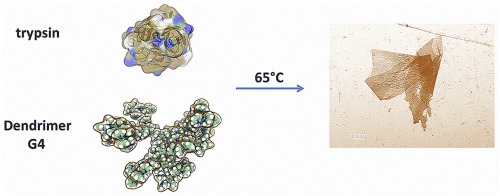Polymer ( IF 4.1 ) Pub Date : 2018-01-08 , DOI: 10.1016/j.polymer.2018.01.015 Yulia Stroylova , Svetlana Sorokina , Victor Stroylov , Aleksandra Melnikova , Cedric Gaillard , Zinaida Shifrina , Thomas Haertlé , Vladimir I. Muronetz

|
The use of materials based on protein-polymer compositions is a promising method for solving a number of problems in biotechnology and medicine. In our work, we produced multilayer nanofilms based on 4th generation (G4) pyridylphenylene dendrimers with fully pyridine-based periphery containing a protein component. For dairy beta- and kappa-caseins, alpha-lactalbumin, recombinant sheep prion protein, lysozyme, trypsin, and alpha-chymotrypsin the ability to integrate into self-organizing structures about 230–710 nm thick, measured by atomic force microscopy, was found. The formation of nanofilms is dependent on the protein/dendrimer ratio in the initial solution. At the same time, the nanofilms are resistant to pH changes, and the action of detergents. We demonstrated that trypsin and chymotrypsin incorporated into the nanofilms still conserved proteolytic activities and were stable for at least 3 weeks. We have also conducted in silico molecular modeling of the G4 dendrimer interactions with lysozyme. Spatial structure of the dendrimer-protein complex was predicted and most probable variant remained almost intact under 100 ns molecular dynamics simulation conditions. We believe that dendrimer-protein systems are promising tools for possible applications in the development of new stable biomaterials and biosensors.
中文翻译:

第四代吡啶亚苯基树枝状大分子与蛋白质相互作用下自发形成纳米膜
基于蛋白质-聚合物组合物的材料的使用是解决生物技术和医学中许多问题的有前途的方法。在我们的工作中,我们生产了基于第四代(G4)吡啶基亚苯基树枝状聚合物的多层纳米薄膜,该薄膜具有完全基于吡啶的外围结构,其中包含蛋白质成分。对于乳制品的β-酪蛋白和κ-酪蛋白,发现了α-乳白蛋白,重组绵羊pr病毒蛋白,溶菌酶,胰蛋白酶和α-胰凝乳蛋白酶,它们能够通过原子力显微镜观察到整合成约230-710 nm厚的自组织结构的能力。 。纳米膜的形成取决于蛋白质/树状聚合物的比例在最初的解决方案中。同时,纳米膜对pH值变化和去污剂的作用具有抵抗力。我们证明了掺入纳米膜中的胰蛋白酶和胰凝乳蛋白酶仍能保持蛋白水解活性,并且稳定至少3周。我们还对G4树状聚合物与溶菌酶的相互作用进行了计算机分子建模。可以预测树状大分子-蛋白质复合物的空间结构,并且在100 ns分子动力学模拟条件下,最可能的变异体几乎保持完整。我们相信,树状大分子蛋白质系统是在开发新型稳定生物材料和生物传感器方面可能应用的有前途的工具。











































 京公网安备 11010802027423号
京公网安备 11010802027423号